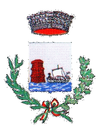Martinsicuro
| Martinsicuro | ||
|---|---|---|
| Comune | ||
| Comune di Martinsicuro | ||
 |
||
|
||
| Location of Martinsicuro in Italy | ||
| Coordinates: 42°53′N 13°55′E / 42.883°N 13.917°E | ||
| Country | Italy | |
| Region | Abruzzo | |
| Province / Metropolitan city | Teramo (TE) | |
| Frazioni | Villa Rosa | |
| Government | ||
| • Mayor | Paolo Camaioni | |
| Area | ||
| • Total | 14 km2 (5 sq mi) | |
| Elevation | 2 m (7 ft) | |
| Population (1 January 2009) | ||
| • Total | 16,993 | |
| • Density | 1,200/km2 (3,100/sq mi) | |
| Demonym(s) | Martinsicuresi | |
| Time zone | CET (UTC+1) | |
| • Summer (DST) | CEST (UTC+2) | |
| Postal code | 64014 | |
| Dialing code | 0861 | |
| Patron saint | St. Gabriel | |
| Saint day | 27 February | |
| Website | Official website | |
Martinsicuro (Latin: Castrum Truentinum) is a town and comune in province of Teramo, Abruzzo, central Italy. It is located on the right of the mouth of Tronto River.
Remains of a Bronze Age (10th-9th centuries BC) settlement were found in the communal territory, on a hill overlooking the Tronto river. At the river's mouth existed Truentum, remembered by Roman writer Pliny the Elder as part of the Roman region of Picenum, and attributed to the Liburni tribe. It was noted during the Roman civil wars as one of the centers occupied by Julius Cesar Cic. to Att.. It is cited by Strabone, Mela and Sillo Italico, also reported in the "Antonini Itinerary" and in the "Peutingeriana Tabula". The territories alongside of his river were divided under the reform of emperor August. After the Roman conquest in the 3rd century BC it became a municipium and later was reached by the Via Salaria. In the city passes also Julius Caesar, Cicero as recalled in the letters to Atticus. And 'cited by Sillo Italico and geographer Pomponius Mela, is reported in "Itinerarius Antonini" and "Tabula Peutingeriana".
After the Roman conquest in the 3rd century BC was City Hall with the name of Castrum Truentinum. The excavations in the locality "Case Feriozzi" between 1991 and 1995 have unearthed the remains of the city [6], a commercial district, already existing in the 2nd century BC and implanted the second regular town planning. In the Augustan period was extended to the mouth of the Tronto and Castrum Truentinum via Salaria.
The historic core of Martinsicuro (in "Case Feriozzi") has clear traces of reusing stone remains of the ancient Roman city of Castrum Truentinum, cities whose exact location had been lost for centuries. Although in past centuries were not rare discoveries of relics around Martinsicuro such as amphorae, lamps. iscription, friezes (the famous frieze Fund Brass discovered in 1937), stone altars, coins, lead pipes, large tiles, fragments of plaster, was in the period from 1991 to 1995 that were conducted targeted excavations on the southern bank of the mouth of the river Tronto, excavations, under the direction of Andrea Staffa, unearthed tracks of urban pavements, walls of buildings, a public fountain, taverns and ducts, remnants of statuary groups bronze, stone inscriptions, arule stone, pieces of household gods, coins and objects of various kinds which testified to the existence of the ancient maritime city of Castrum Truentinum. Were identified various urban areas of the city, the Macellum (for the public life), in the immediate vicinity of the port, the shopping district consists mostly of environments for the supply of goods (which were transported by sea via the port and ground through the Via Salaria) .The activities were based mainly on trade, crafts and sea fishing, as evidenced by both the finds of objects (hooks, needles and fragments of fishing nets) that funerary inscription in memory of purpurarius (dealer in purple) Caius Marcilius also mentioned as "quinquevires" the city in the same inscription. Some Truentini are also mentioned as military, as evidenced by the epitaph commemorating the death of two young brothers (one military tribune and the other centurion) owned by the family of Allidia Castrum Truentinum. Or the funerary inscription in memory of Caius Pollius, citizen of Truentum and praetorian guard, found along the Via Salaria in Rome in 1736. Other inscriptions testify to the existence of an administrative and religious at the city such as the priestly college of seviri Augustales for the imperial cult or an institution made up of five men (quinquevires) of which is not clear and the function of which certainly belonged to the mentioned Caius Pollius.Sul end of the 6th century AD the city was gradually abandoned, both because of the economic and political crisis that blows throughout the Roman Empire, both because advancing shoreline that the height of the Adriatic railway stepped inward until near the coast, making the swampy village.
...
Wikipedia


